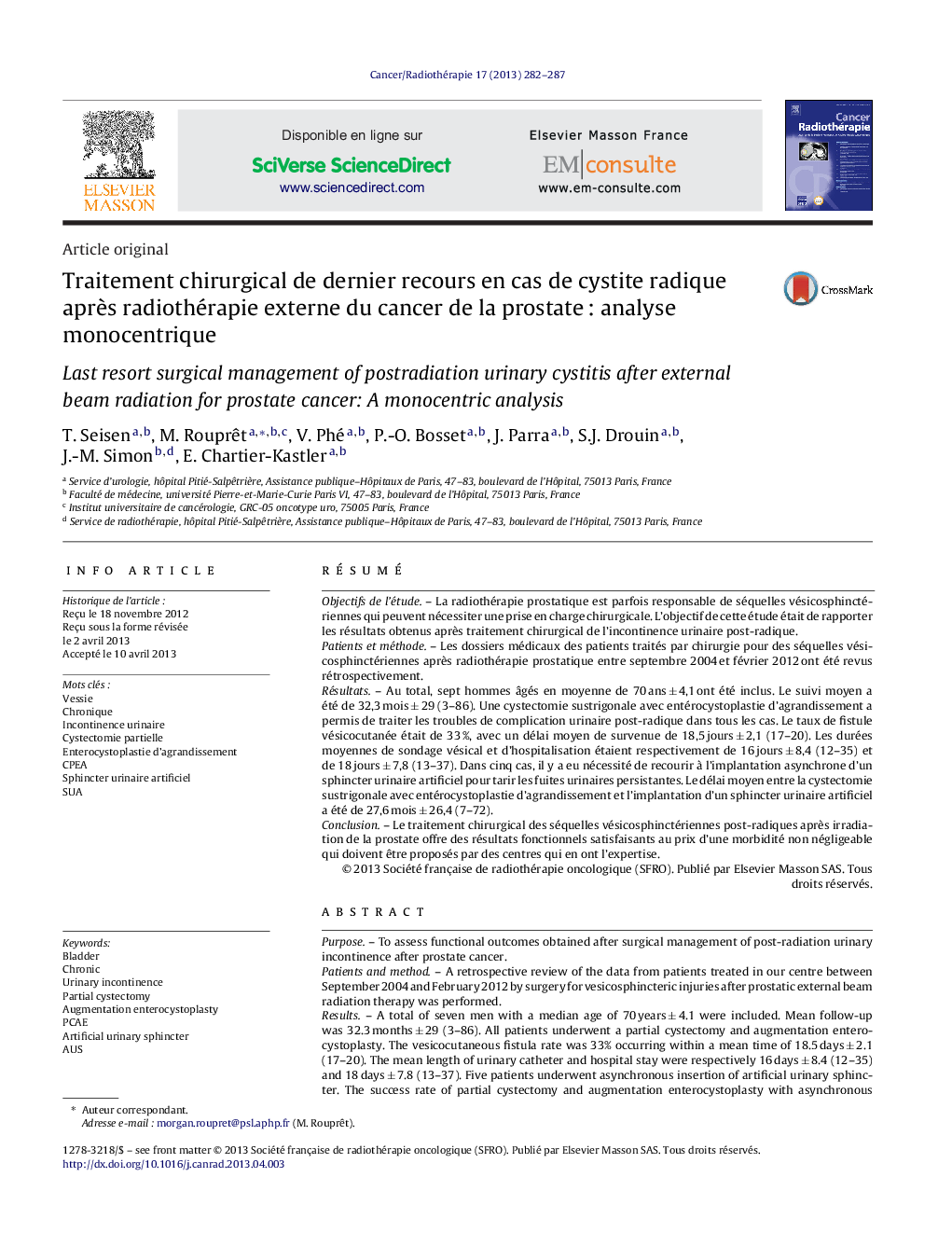| کد مقاله | کد نشریه | سال انتشار | مقاله انگلیسی | نسخه تمام متن |
|---|---|---|---|---|
| 2118035 | 1085220 | 2013 | 6 صفحه PDF | دانلود رایگان |

RésuméObjectifs de l’étudeLa radiothérapie prostatique est parfois responsable de séquelles vésicosphinctériennes qui peuvent nécessiter une prise en charge chirurgicale. L’objectif de cette étude était de rapporter les résultats obtenus après traitement chirurgical de l’incontinence urinaire post-radique.Patients et méthodeLes dossiers médicaux des patients traités par chirurgie pour des séquelles vésicosphinctériennes après radiothérapie prostatique entre septembre 2004 et février 2012 ont été revus rétrospectivement.RésultatsAu total, sept hommes âgés en moyenne de 70 ans ± 4,1 ont été inclus. Le suivi moyen a été de 32,3 mois ± 29 (3–86). Une cystectomie sustrigonale avec entérocystoplastie d’agrandissement a permis de traiter les troubles de complication urinaire post-radique dans tous les cas. Le taux de fistule vésicocutanée était de 33 %, avec un délai moyen de survenue de 18,5 jours ± 2,1 (17–20). Les durées moyennes de sondage vésical et d’hospitalisation étaient respectivement de 16 jours ± 8,4 (12–35) et de 18 jours ± 7,8 (13–37). Dans cinq cas, il y a eu nécessité de recourir à l’implantation asynchrone d’un sphincter urinaire artificiel pour tarir les fuites urinaires persistantes. Le délai moyen entre la cystectomie sustrigonale avec entérocystoplastie d’agrandissement et l’implantation d’un sphincter urinaire artificiel a été de 27,6 mois ± 26,4 (7–72).ConclusionLe traitement chirurgical des séquelles vésicosphinctériennes post-radiques après irradiation de la prostate offre des résultats fonctionnels satisfaisants au prix d’une morbidité non négligeable qui doivent être proposés par des centres qui en ont l’expertise.
PurposeTo assess functional outcomes obtained after surgical management of post-radiation urinary incontinence after prostate cancer.Patients and methodA retrospective review of the data from patients treated in our centre between September 2004 and February 2012 by surgery for vesicosphincteric injuries after prostatic external beam radiation therapy was performed.ResultsA total of seven men with a median age of 70 years ± 4.1 were included. Mean follow-up was 32.3 months ± 29 (3–86). All patients underwent a partial cystectomy and augmentation enterocystoplasty. The vesicocutaneous fistula rate was 33% occurring within a mean time of 18.5 days ± 2.1 (17–20). The mean length of urinary catheter and hospital stay were respectively 16 days ± 8.4 (12–35) and 18 days ± 7.8 (13–37). Five patients underwent asynchronous insertion of artificial urinary sphincter. The success rate of partial cystectomy and augmentation enterocystoplasty with asynchronous implantation of artificial urinary sphincter to treat post-radiation urinary incontinence was 71.5%. The median time between partial cystectomy and augmentation enterocystoplasty and artificial urinary sphincter implantation was 27.6 months ± 26.4 (7–72).ConclusionSurgical management of post-radiation urinary cystitis offers good functional outcomes albeit its morbidity is not negligible. It should be proposed only in expert surgical centres.
Journal: Cancer/Radiothérapie - Volume 17, Issue 4, July–August 2013, Pages 282–287